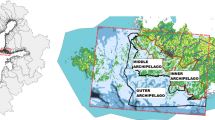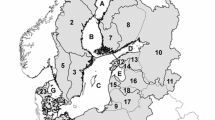Abstract
Occurrence of wide anoxic black areas in the East Frisian Wadden Sea at the beginning of the summer of 1996 has highlighted adverse effects of eutrophication once again and reminded of the persisting need for further reduction of nutrient inputs.
The Wadden Sea as part of the North Sea is subject to mosdy the same political and legal agreements. However, internationally accepted decisions are often overridden by national policy considering economic interests. Furthermore, the envisaged 50% reduction in nutrient inputs is merely a political figure: Based on indications from ecological models and dose-effect-relationships, one has to call for a reduction of nitrogen and phosphorus inputs by, e.g., 75 to 85% in order to achieve a reduction of anthropogenic algal biomass by 50%. Thus, further measures as agreed by the Intermediate North Sea Ministerial Meeting (IMM, 1993) and the 4th North Sea Conference (NSC, 1995) are insufficient if aiming at a 50% reduction only. Secondary eutrophication from sediments and soil retention delay perceptible effects for several years and result in a high patchiness of responses.
Since 1993, OSPAR’s nutrient work is paralysed by technical discussions on the definition of Balanced Fertilisation and the Strategy to Combat Eutrophication. No comprehensive strategy to combat eutrophication has been adopted yet. The unresolved issue of EU competence questions OSPAR’s role in agriculture policy and other areas.
An operational concept of balanced fertilisation must achieve a simultaneous reduction of nitrogen and phosphorus inputs in order to avoid changes in the N:P ratio disturbing the ecosystem. Measures implemented so far have proven ineffective to reduce nitrogen inputs by more than 30%. Reduction effects from point sources are exhausted in near future, but diffuse sources remain to be a problem. The emission sources within transport and vehicle traffic have only been addressed in terms of inventories, but have not yet been approached with reduction programmes and measures by OSPAR.
Precautionary reductions at source are at least as important as comprehensive monitoring programmes which can only recall the need for action. They are ecologically and economically more favourable than prolonged cost- and time-consuming research into cause-effect-relationships. Restoration measures and coastal management can support, but in no means replace far-reaching preventive measures to combat eutrophication.
Kurzfassung
Das Auftreten großer anoxischer, schwarzer Flächen am Anfang des Sommers 1996 im Ostfriesischen Wattenmeer hat die nachteiligen Auswirkungen der Eutrophierung wieder einmal hervorgehoben und an die andauernde Notwendigkeit einer weiteren Reduktion der Nährstoffeinträge erinnert.
Das Wattenmeer als Teil der Nordsee unterliegt größtenteils den gleichen politischen und rechtlichen Übereinkünften. Jedoch werden international akzeptierte Entscheidungen oft nicht durch die von eigenwirtschaftlichen Interessen dominierte nationale Politik berücksichtigt. Außerdem ist die angestrebte 50%-Reduktion eine rein politische Zahl: Gestützt auf Hinweise aus ökologischen Modellen und Dosis-Effekt-Beziehungen muß man eine Reduktion der Stickstoff- und Phosphoreinträge um z. B. 75 bis 85% fordern, um eine Reduktion der anthropogenen Algen-Biomasse um 50% zu erreichen. Daher sind weitere Maßnahmen, wie beim Interimstreffen der Nordseeminister 1993 (IMM, 1993) und bei der Vierten Nordseeschutz-Konferenz (INK, 1995) beschlossen, unzureichend, wenn sie nur auf eine 50%-Reduktion abzielen. Sekundäre Eutrophierung aus dem Sediment und Nährstoffspeicherung im Boden verzögern mögliche Effekte um Jahre und resultieren in großen zeidichen Schwankungen der Reaktionen des Ökosystems.
Seit 1993 ist die Arbeit der OSPAR-Kommissionen über Nährstoffe durch technische Diskussionen über die Definition ausgewogener Düngung und über die Strategie zur Bekämpfung der Eutrophierung gelähmt. Eine umfassende Strategie gegen Eutrophierung wurde bisher nicht verabschiedet. Der ungelöste Streit über die EU-Kompetenz stellt OSPARs Rolle in der Landwirtschaftspolitik und anderen Sektoren in Frage.
Ein operationelles Konzept zur ausgewogenen Düngung muß eine Reduktion der Stickstoff- und Phosphoreinträge gleichzeitig erreichen, um das Ökosystem störende Veränderungen des N:P-Verhältnisses zu vermeiden. Bisher umgesetzte Maßnahmen haben sich als unwirksam erwiesen, um Stickstoffeinträge um mehr als 30% zu reduzieren. Reduktionseffekte aus Punktquellen werden in naher Zukunft erschöpft sein, diffuse Quellen bleiben aber ein Problem. Die Emissionsquellen im Verkehrs- und Kraftfahrzeugbereich wurden bisher nur in Form von Emissionsregistern angegangen, jedoch noch nicht durch OSPAR-Programme und -Maßnahmen.
Vorsorgliche Reduktionen an der Quelle sind mindestens ebenso wichtig wie umfassende Monitoring-Programme, die den Handlungsbedarf nur in Erinnerung rufen können. Erstere sind ökologisch und ökonomisch günstiger als fortgesetzte kosten- und zeitraubende Forschung über Ursache-Wirkungs-Beziehungen. Küstenschutzmaßnahmen und Küstenmanagement können weitreichende Präventivmaßnahmen zur Bekämpfung von Eutrophierung unterstützen, aber in keiner Weise ersetzen.
Similar content being viewed by others
References
Bechmann, A. &Meier-Schaidnagel, R. (1996): Zukunftsfähige Landwirtschaft — Ökologischer Landbau flächendeckend. —Abstr.: 18 pp.; Barsinghausen (Inst. ökol. Zukunftsperspektiven).
BEON (1989): Findings of the BEON Workshop in preparation for the Third North Sea Conference. — BEON-Rep. No. 6, July 1989.
Boers, P. &Laane, W. &van Liere, L. &Peeters C. &Parma, S. &Van der Does, J. (1993): Eutrofiering en beleid en Nederland, hoe verder? (Workshop 27 January, 1993). —RIZA (Rijksinstituut voor Integral Zoetwaterbeheer en Afwalwaterbehandeling), Lelystad, RIVM (Rijksinstituut voor Volksgezondheid en Milieuhygiene): 51 pp.; Bilthoven.
Cadée, G. C. (1992): Trends in Marsdiep phytoplankton. — Netherl. Inst. Sea Res., Publ. Sen,20: 143–149.
Cadée, G. C. & Hegeman, J. (1993): Persisting high levels of primary production at declining phosphate productions in the Dutch coastal area (Marsdiep). — Netherl. J. Sea Res.,31 (2): 147–152.
Common Wadden Sea Secretariat (1989): Progress Report by the Wadden Sea States —The Implementation of the London Declaration. -38 pp.; Wilhelmshaven (CWSS).
—— —— —— (1994): Ministerial Declaration of the Seventh Trilateral Governmental Conference on the Protection of the Wadden Sea. —154 pp.; Wilhemshaven (CWSS).
—— —— —— (1996): Black Spots Newsbull.,2–96.: 4 pp.; CWSS, Wilhemshaven.
De Jonge, V. N. (1990): Response of the Dutch Wadden Sea ecosystem to phosphorus discharges from the River Rhine. — Hydrobiol.,195:49–62.
Ebenhöh, W (1996): Das ERSEM-Modell. — Mitt. Dt. Ges. Meeresforsch.,1/96: 8–16.
Eberlein, K. (1994): Risk of anthropogenic nitrogen and phosphorus input for the ecosystem of the North Sea. — Zentralbl. Hygiene Umweltmed.,196 (4): 285–311.
Edvardsen, B. & Moy, F. & Paasche, E. (1990): Hemolytic activity in extracts ofChrysochromulinapofylepis grown at different levels of selenite and phosphorus. —In: Graneli, E. & Sundström, B. & Edler, L. & Anderson, D. M. [Eds.]: Toxic marine phytoplankton. — New York (Elsevier).
Elliott, M. &De Jonge, V. (1996): The Need for Monitoring the Monitors and Their Monitoring. — Mar. Pollution Bull.,32 (3): 248–249.
Helsinki Commission (1995): Report of the Sixth Meeting of the Technological Committee. —152 pp.; Helsinki (HELCOM).
-- -- -- (1996): Report of the 17th Meeting of the Helsinki Commission. - 164 pp.; Helsinki. (HELCOM).
Hesse, K.-J. &Tillmann, U. &Brockmann, U. (1995): Nutrient-Phytoplankton relations in the German Wadden Sea. —ICES C. M. 1995/T: 8.
Hickel, W. (1993): Nährstoffe, Phytoplankton, Algenblüten. — In: SDN-Kolloquium, 22.10.92: Geht es der Nordsee besser? — 177 pp.; Schutzgem. Dt. Nordseeküste.
Hickel, W. &Eickhoff, M. &Spindler, H. (1995): Long-term investigations of inorganic nutrients and phytoplankton in the inner German Bight. — Dt. hydrogr. Z., Suppl.5: 197–211.
Höpner, T. (1994): Variability and inhomogeneity — guidelines of ecosystem research in the Wadden Sea of Lower Saxonia. — Ophelia,S6: 153–162.
-- -- -- (1996): Schwarze Tage im Nationalpark Wattenmeer. -Spektr. Wiss., 1996 (8): 16–22.
ICPR (1987): International Commission for the Protection of the Rhine — Action Programme “Rhine”. — 28 pp.; Technical and Scientific Secretariat; Koblenz.
Isermann, K. (1990): Share of agriculture in nitrogen and phosphorus emissions into the surface waters of Western Europe against the background of their eutrophication. — Fertilizer Res.,26: 253–269.
Kolbe, K. &Kaminski, E. &Michaelis, H. &Obert, B. &Rahmel, J. (1995): Macroalgal Mass Development in the Wadden Sea — First Experiences with a Monitoring-System. — Helgoländer Meeresunters.,49 (1–4): 519–528.
Maggs, J.J. (1995): The Ministerial Declaration of the Fourth North Sea Conference. — North Sea Monitor,2: 4–24.
Nationalparkverwaltung Niedersächsisches Wattenmeer (1995): Watt und mehr. — Ein Ökosystem, seine Erforschung und sein Schutz. — Begleitschr. zur Ausstellung.: 75 pp.; Wilhelmshaven (Nationalparkverw. Niedersächs. Wattenmeer).
Nelissen, P. H. M. &Stefels, J. (1988): Eutrophication in the North Sea. -Nederl. Inst. Onders. Zee Rep., 1988-4.
North Sea Conference (1995): Ministerial Declarations. — 129 pp; Copenhagen (Dan. Environ. Protect. Agency).
-- -- -- (1996): Draft Report on Existing Reporting Systems and Procedures on Nutrients. — Document 96/5/5; CONSSO June 1996.
-- -- -- (1993): North Sea Quality Status Rep. 1993. —Fredensborg (Olsen & Olsen).
Oslo And Paris Commissions (1992): Report on the Activities of the Oslo and Paris Commissions 1989–1992. — 112 pp.; London (OSPARCOM).
—— —— —— (1993a): Summary Record of the 15th Meeting of the Oslo and Paris Commissions. — 55 pp.; London (OSPARCOM).
—— —— —— (1993b): Summary Record of the 8th Meeting of the Working Group on Nutrients. —20 pp.; London (OSPARCOM)
—— —— —— (1993c): Nutrients in the Convention Area. — 86 pp.; London (OSPARCOM).
—— —— —— (1993d): Eutrophication Symptoms and Problem Areas. — 26 pp., London (OSPARCOM).
—— —— —— (1995a): Summary Record of the Meeting of the Programmes and Measures Committee 1995. —37 pp.; London (OSPARCOM).
—— —— —— (1995b): Nutrients in the Convention Area. — 60 pp.; London (OSPARCOM).
—— —— —— (1996a): Summary Record of the Meeting of the Programmes and Measures Committee 1996. —57 pp.; London (OSPARCOM).
-- -- -- (1996b): Doc. NUT,96/6/6-E: 7 pp.; London (OSPARCOM).
—— —— —— (1996c): Summary Record of the Meeting of the AdHoc Working Group to Further Elaborate a Conceptual Framework on the Strategy to Combat Eutrophication (STRAT). —5 pp.; London (OSPARCOM).
—— —— —— (1996d): Outline of the Conceptual Framework on OSPAR’s Strategy to Combat Eutrophication. — Doc. NUT, 96/5/3-E: 56 pp.; London (OSPARCOM).
—— —— —— (1996e): Overview on atmospheric emissions of nutrients form sources other than traffic. — Doc. NUT,96/9/1-E: 16 pp.; London (OSPARCOM).
Peeters, J. C. H. &Laane, R. W. P. M. &Peperzak, L. (1993): De relatie tussen nutriënten in de Rijn en in het kustwater van de Noordzee: Effecten en doelen. —In: Boers et al. (1993): 13–24.
Reise, K. (1995): Predictive ecosystem research in the Wadden Sea. — Helgoländer Meeresunters.,49: 495–505.
Sturm, H. &Knittel, H. &Zerulla, W. (1988): Einfluß der N-Düngung auf Ertrag und N-Mineralisationsverhalten im Boden in langjährigen Dauerversuchen. — VDLUFA-Schriftenr.,28:113–134. — [Kongreßband, Tl. II].
Umweltbundesamt (1994): Stoffliche Belastung durch die Landwirtschaft und Maßnahmen zu ihrer Verringerung. — UBA-Berichte, 2/94; Berlin (Erich Schmidt).
Van Beusekom, J. &Diehl-Christiansen, S. (1993): A Synthesis of Phyto- and Zooplankton Dynamics in the North Sea Environment. — 148 pp.; WWF Internat.
Vertegaal, P. (1996): Tackling Nutrient Pollution from Agriculture. — North Sea Monitor,1: 10–15.
Waterpakt (1994): Vermesting van de Zee; komen we er vanaf? (Workshop, 22 October, 1993) — 58 pp.; Amsterdam, Harlingen (Waterpakt).
Weins (1996): Düngeverordnung — Weiter freier Güllefluß. — Naturschutz heute,2/96: 25.
Wodsak, H. P. &Behrendt, H. &Werner, W. (1994): Gesamteintrag an Stickstoff und Phosphor auf dem Gebiet der ehemaligen DDR (incl. Berlin) und Gesamtdeutschlands aus diffusen und punktförmigen Quellen. -In: Werner, W & Wodsak, H. P. [Eds.] : Stickstoff- und Phosphateintrag in Fließgewässer Deutschlands unter besonderer Berücksichtigung des Eintragsgeschehens im Lockergesteinsbereich der ehemaligen DDR. — Agrarspektrum Schriftenr.,22: 234 pp; (Verlagsunion Agrar).
Author information
Authors and Affiliations
Rights and permissions
About this article
Cite this article
Kaiser, J., Lutter, S. Do we have the right strategies to combat eutrophication in the Wadden Sea? — A critical review of current policies. Senckenbergiana maritima 29, 17–24 (1998). https://doi.org/10.1007/BF03043939
Received:
Revised:
Accepted:
Issue Date:
DOI: https://doi.org/10.1007/BF03043939




